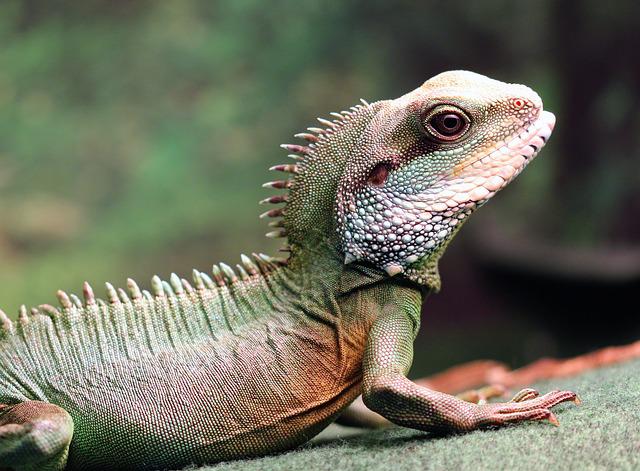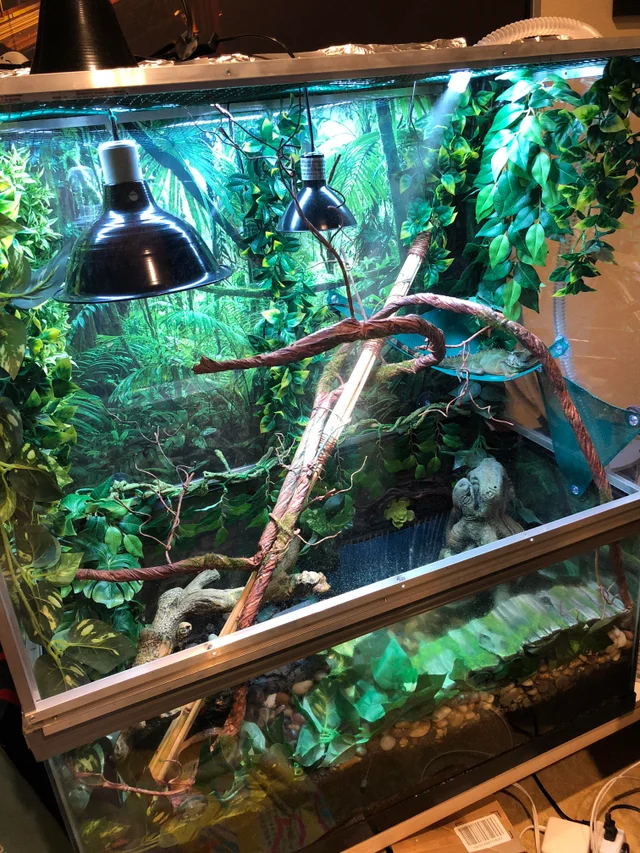The Chinese water dragon (Physignathus cocincinus) is a species of lizard, native to China and Indochina. It is also known as “Asian Water Dragon”, “Thai Water Dragon” and “Green Water Dragon”. Chinese water dragons can grow to a length of 1 meter including the tail and can live 10 to 15 years.
Chinese water dragon in the wild
Their colors range from dark green to light green. Diagonal green or turquoise stripes are visible on the body, while the tail is ringed green and dark brown from center to end. On the belly, the color varies from white to ivory, very pale green to pale yellow. On the throat, Chinese water dragons have distinctive colors: white and blue or peach; some are solid, some are striped.

Adult males are usually larger than females, with a larger, triangular head, and larger crests on the head, neck, and tail. With a tail that makes up a little over two-thirds of its body length, it can be used as a weapon to help with balance and swimming.
The species has emerged as an invasive species in established populations in Hong Kong, possibly due to the introduction of pet specimens into the wild. It most often inhabits the shores of freshwater lakes and streams. It is a typical diurnal animal, spending most of its time in trees and plants, drinking and hunting. When threatened, the lizard jumps into the water where it can submerge for up to 25 minutes.
Keeping Chinese water dragon as a pet
The Chinese water dragon is one of the preferred species for home keeping as its gentle temperament, ability to mimic its owner, receptivity, and low maintenance requirements also make it ideal for beginners!
Many animal owners prefer these species because they seek out contact with their owners and enjoy daily walks around the room and being handled.
Inexperienced exotic pet enthusiasts often mistake this species for an iguana, because both lizards look similar at an early age.
Tank requirements
As a baby, the Chinese water dragon can be kept in a smaller terrarium, which also makes it easier for him to catch food.
A terrarium for an adult Chinese water dragon should be a minimum of 75 gallons (285 liters). Ideally, 120 x 90 x 150 cm / 3.9ft x 2.9ft x 9ft.
Side and back windows of the terrarium should be covered with cork plates or you can model artificial rocks out of styrofoam or synthetic resin. Such an interior is not only decorative but also prevents frightened agamas from breaking their snouts on the glass and getting seriously injured. Such behavior is (unfortunately) typical for these lizards: In case of imminent danger they react in a flash with undirected flight reactions. This should be taken into special consideration when dealing with the animals and act prudently.
Tank placement
The optimal place for your Chinese water dragon’s habitat will rely on accessibility, visibility, lighting, and safety. Make sure the cage is in a location where you and your visitors can see your dragons in action because these creatures are magnificently gorgeous. Of course, the most crucial thing to remember is to always make sure the cage is simple to access for feeding, cleaning, and maintenance, as well as that the right amount of lighting and humidity is kept in place. Most essential, make sure the cage is in a secure location where kids or other animals can’t unintentionally run into it or get to it.
Water and humidity in the tank
We can all tell from its name that this species adores water. The animal must have access to a deep water area where it may bathe, play, and slake its thirst. The humidity level should be between 60 and 80 percent. The easiest method to do this is to place the water container partly under the heating pad. The water will gradually evaporate and the moisture will only be felt in the terrarium, negating the need for spraying with a spray bottle.
Temperature and Lighting
The temperature inside the glass container should not exceed 28-30C, the easiest and safest for animals is a heating pad. Because splashing can occur when bathing in the tank, and in the presence of heat lamps, the risk of animals splashing water and injuring themselves is very high. Chinese water dragons are diurnal and therefore require the sun’s UV rays and vitamins provided through the skin.
Since the sun has a different intensity range in its homeland, UVB bulbs must be used in terrariums. To avoid adding extra lights to UVA, a combination of UVB+UVA can also be used. However, be mindful of the distance between the bulbs and the basking area. Many pet owners put a safety cage on the bulb to prevent accidents.

Image credit: reddit u/Rucku5
Interior
A pool of water: In order to create a terrarium appropriately, you need also take into account the fact that water dragons love to be close to water in their native environment. A minimum depth of 20 to 25 cm / 7”-9” is required for the water portion, which should cover about 50% of the floor space. Check the water throughout the day to make sure it is clean, and change or refresh the water as needed.
Substrates: Natural substrates may be used to build the remainder of the land portion. However, soil-sand mixes soon cause water pollution, increasing the need for maintenance. Artificial rocks or other stable platforms like stone slabs are commonly accepted. The impulse to move is naturally satiated by thick climbing branches that stick out over the water and other climbing opportunities.
Hiding and climbing spots: Chinese water dragons are arboreal creatures that enjoy climbing and hiding in trees and other vegetation. Logs and tree branches, real or artificial plants for climbing, and rock caverns for hiding can all be used to simulate this. Select “caves” that can accommodate the dragon’s whole body. Just remember to routinely clean and sterilize every item in your dragon’s tank to stop the growth and spread of germs and fungus.

What to feed a Chinese water dragon
As food opportunists, water dragons eat pretty much anything. These include different kinds of small fish, worms, insects, crustaceans, other tiny reptiles, tiny animals, and birds. Aside from living a carnivorous lifestyle, they do not dislike eating vegetables. Different fruits and vegetables are particularly favorites of the water dragon.
Typically, when kept as a pet, fruits and vegetables should make up 10–15% of your Chinese water dragon’s diet, with insects making up the rest 85%–90%.
You should feed your pet dragon no more than twice a week, and only if your dragon is big enough to manage them. Whole prey, such young or infant mice, may be an excellent source of protein.
Among other things, you may give your agama the following foods:
| Insects | Produce | Meat |
|---|---|---|
| Earthworms | Vlueberries | Small feeder fish |
| Crickets | Raspberries | Newborn mice |
| Wax worms | Cantaloupe | |
| Butter worms | Figs | |
| Mealworms | Collard greens | |
| Grasshoppers | Carrots | |
| Potato |
After a short while, your water dragon’s unique preferences will become clear. A healthy, diverse diet should always be prioritized. Before feeding, you can sprinkle the food animals with the appropriate vitamin formulations. Animals shouldn’t be overfed since doing so will cause them to gain weight more quickly, which will reduce how long they live.
Food should always be sprinkled with calcium and vitamins!
Common Health Issues in Chinese Water Dragons
Keeping a healthy pet Chinese water dragon starts out with the choice. We constantly advise purchasing pets from respectable breeders or pet stores. Always choose captive-bred versus wild-caught dragons because the latter could not adapt well to confinement. Additionally, they frequently arrive parasite-ridden on the inside and outside. After you’ve taken your new pet home, it’s critical to keep its environment clean for its health. Like any animal, your pet dragon may have a few health issues that you should be aware of.
Mouth decay/ Mouth rot
One of the most prevalent health issues, mouth rot usually results from an injury that is left untreated or a subsequent illness that is not effectively managed. Water dragons frequently hit or brush their head, nose, and chin against the enclosure walls. This conduct frequently results in mouth rot and rub sores. Swelling around the mouth, open sores around the mouth or nose, and discharges that resemble white curd might all be indicators that your Chinese water dragon has mouth rot. You should visit your reptile veterinarian right once if you have any of these symptoms. Additionally, keep stress to a minimum so your dragon won’t rub up against the walls as much.
Metabolic and nutritional disorders
MBD, or metabolic bone disease, is a very dangerous and sometimes deadly condition that affects these animals. Either a deficiency in calcium in the dragon’s diet or insufficient UVB exposure are to blame. Twitching, lethargy, shattered bones, muscular spasms, and swelling of the legs or back are symptoms that your dragon may have MBD. The best treatment for MBD is prevention; all it generally requires is a little calcium powder dusted over every other meal and constant exposure to UVB and/or sunshine. Consult your veterinarian immediately once if your Chinese water dragon exhibits signs of metabolic bone disease.
